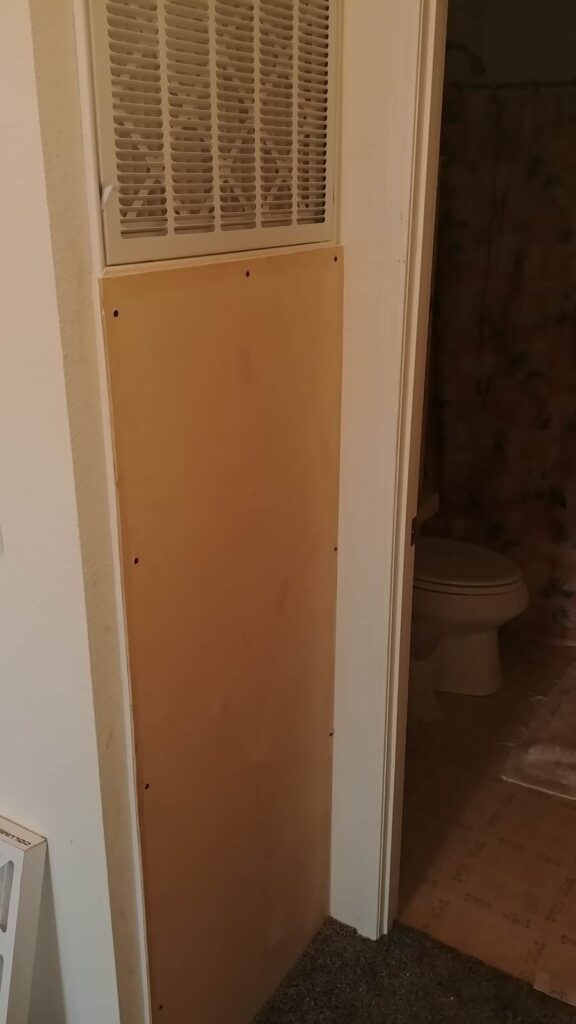Easy, is always in the eyes of the beholder. So let me explain an easy and very effective way to upgrade to a better mobile home furnace filter. The benefits of this upgrade are:
- Better indoor air quality
- Cleaner furnace
- Less maintenance
- Quieter furnace operation

If this is beyond your capability or desire to DIY then you must know or can find someone who can do this simple project.
The first thing most mobile home owners do when wanting to upgrade their existing filter is to get one of those high efficiency pleated 1″ thick filters and stick it in the same furnace filter retainer.
The problem with just changing the type of filter is that it does nothing to lower the noise from a mobile home furnace.
A mobile home furnace air filter location is similar in nearly all models of manufactured homes. Those mobile home furnace door filter applications are absolutely the poorest way to keep a system clean.
Furnace filters in the door are usually of that hog hair material that is washable, but you could poor salt through those things. Think about the dust that filters through.
If the filter isn’t in the door, then it inserts into that skinny little slot at the top of the furnace. Again only allowing a 1″ filter and usually in dimensions of about 16 X 20 inches.
Let’s think outside the box and forget those locations. They only provide enough square inches of filtering to do a very poor job.
I mentioned pleated filters. Imagine a 1″ thick pleated filter expanded out, laying flat on a surface. It has several more square inches of surface that those nasty fiberglass or washable filter you are trying to improve on.
Now imagine if you had a 2″ thick pleated filter expanded out laying flat on a surface. A two inch pleated filter would have twice the square inches of filtering capacity than the one inch pleated.
But even better, what if the filter was 5″ thick. A lot more square inches of filter surface area. But you can get a year or more out of one of these filter unless you have lots of pet hair or a big dusty construction site near by.
Notice the lip around the perimeter of the filter. That’s what fits into and supports the filter in a 1″ filter grille. These are really slick. Take a quick look on Amazon’s site to see current prices and availability. (ad)
How Often Do You Change The Furnace Filter?
Time is never a good indicator of when to change your furnace filter. You could be throwing money away by disposing of a furnace filter that still has usable life remaining.
Or you could be leaving a filter in a furnace too long and causing damage to the system by overheating in the heat cycle and freezing up in the cooling cycle.
Damage that can result from a plugged filter depends on the type of system you have but can include:
- Cracked heat exchanger
- Compressor failure
- High fuel or electric bills
So what is the best way to know you are getting your monies worth when buying furnace filters? And, how do you pick the right filter for your furnace and duct work system?
This is just the beginning of knowledge you need to pick the right filter. The best filter for an HVAC system is one that allows for the correct pressure drop across your air handler or furnace.
What Is Filter Pressure Drop?
I like to think in extremes when trying to understand a principle like air flow and static pressure created by obstacles in the duct system like filters and coils.
Stick a board in the filter retainer or slot of your furnace. The static pressure created by a board in the slot would be so high that it would virtually stop the air flow through the furnace and while in the heating mode the furnace would overheat.
If you have air conditioning or a heat pump, in the cooling mode with a board in the hole the indoor coil would ice up and the iced up coil would become another factor just like the board in filter slot, increasing the static pressure of your system.
A poor quality filter or lack of maintenance can allow dust and other particles to accumulate on the surface of and caught inside the fins of an air conditioning coil reducing air flow and causing high static pressure.
So there is a balance that needs to be found and since nearly all systems vary in one way or another in duct work and blower sizes it makes it impossible to have a cookie cutter filter that will be a one size fits all.
If your system is marginal in size to begin with, sticking the wrong filter in the slot would be detrimental to the life of a furnace, heat pump or air conditioning system.
Can I Measure My Own Filter Static Pressure Drop?
If saving a few bucks created by a service call is important and you have the time to make a few measurements then this is a perfect DIY project that can also give you a perfect way to know not only if you have the right filter but also when your furnace filter needs to be changed .
There are several types of devices to measure static pressure drop. So many of them are without probes and tubing. (ad) This one available on Amazon’s site offers both.
Having a good tool and knowing how to use it are two wildly different things. I found a little technical assistance for you here.
I’ve been scouring over YouTube videos and I guess I’m going to have to make one that addresses this particular test. None of the videos I found showed how to measure the drop across a filter in a grille.
Conclusion
So a mobile home air filter replacement upgrade is not as simple as one may imagine. Lots of things to consider, right? It’s just been my experience that this little upgrade makes a world of difference with air quality and noise.
The mobile home mesh filters and door filters just don’t cut it and in time they will create problems that can be avoided. I’ve seen the mess they leave behind and unless you are willing to dig into the furnace and have a close look you will never see the results.
Like I said, if this project is too much for you, take the time an make a couple of phone calls and find a good tech. Show him or her my article and find out what they think about doing this mobile home air filter location and improvement.

